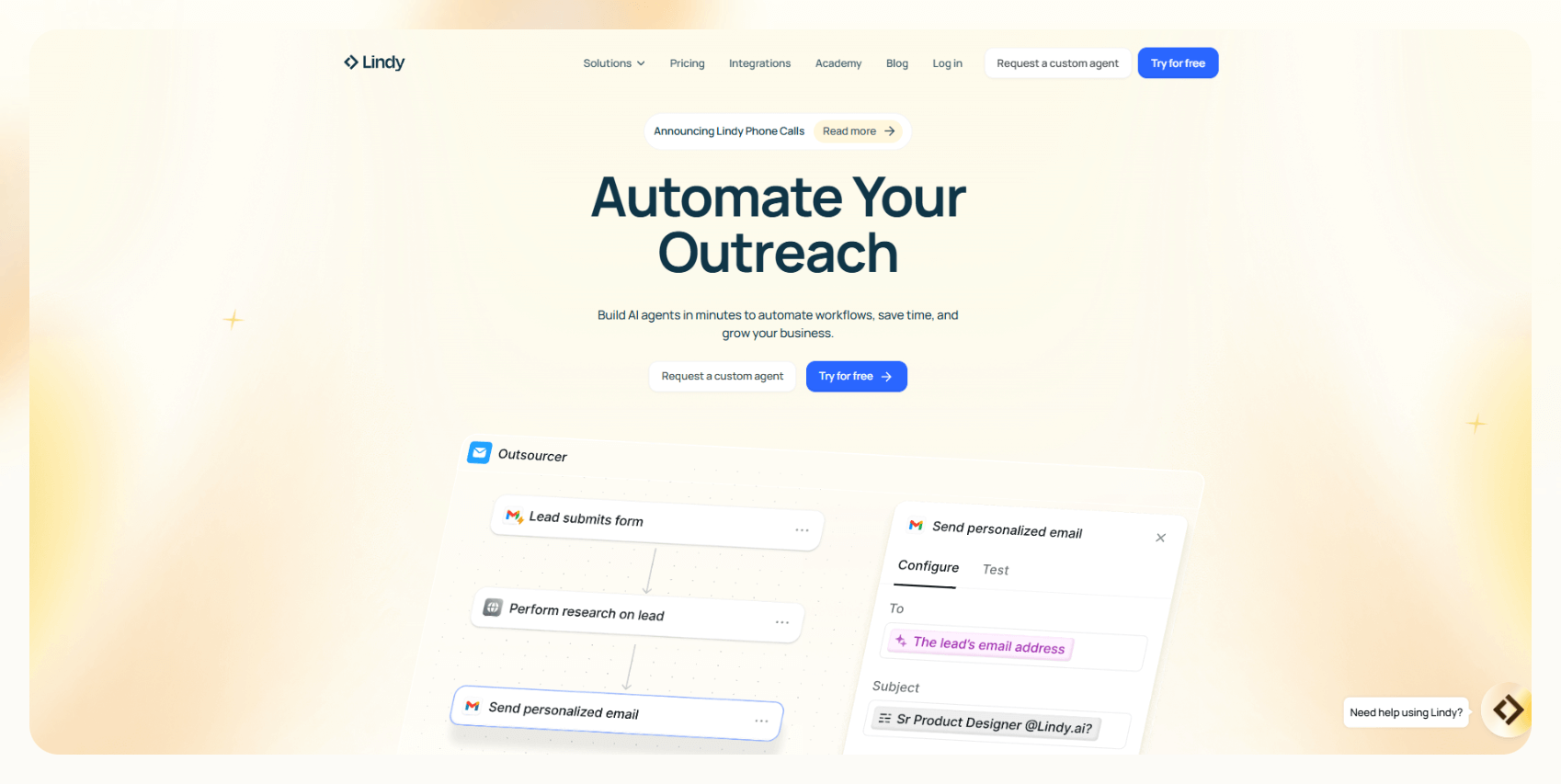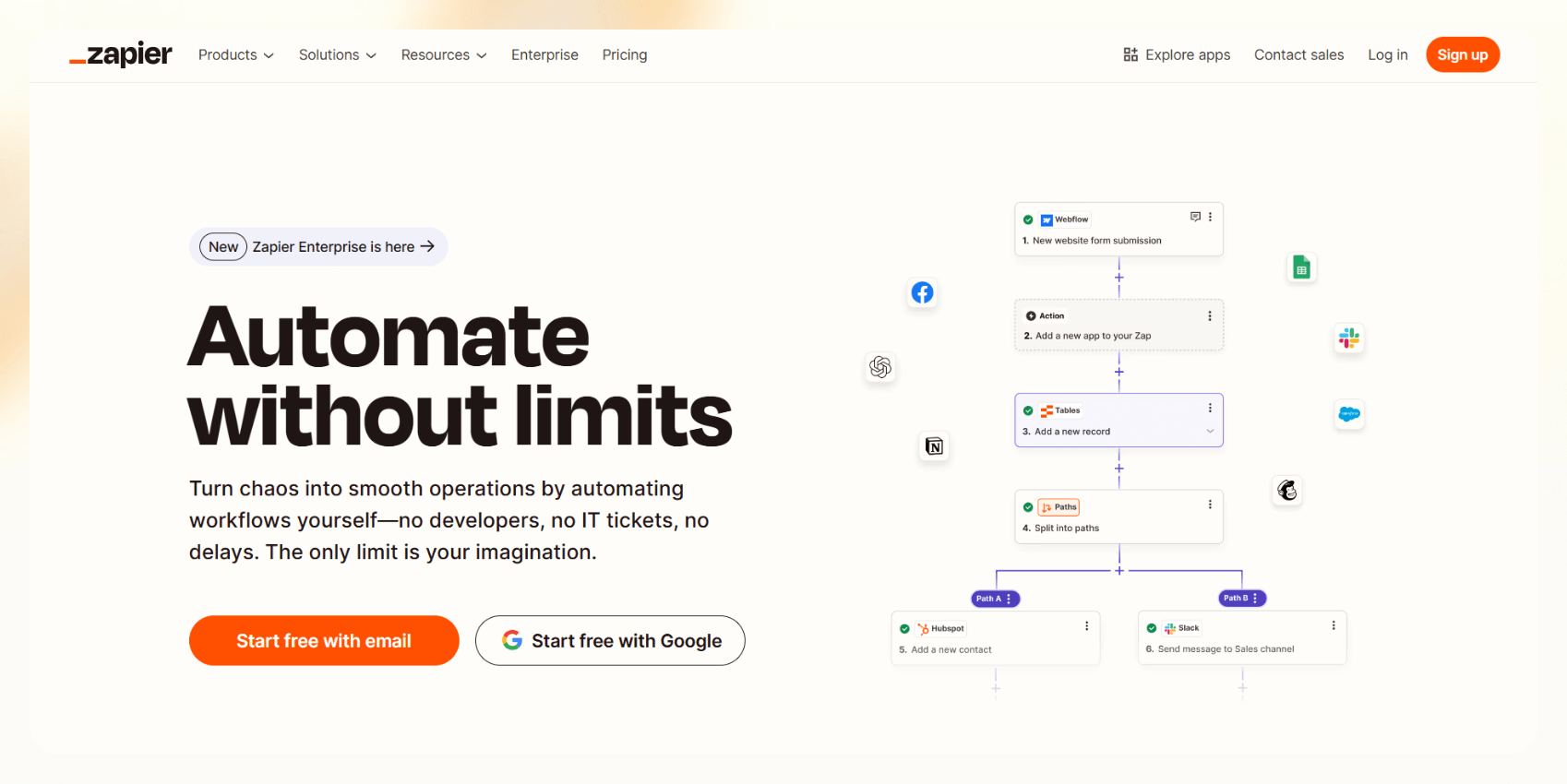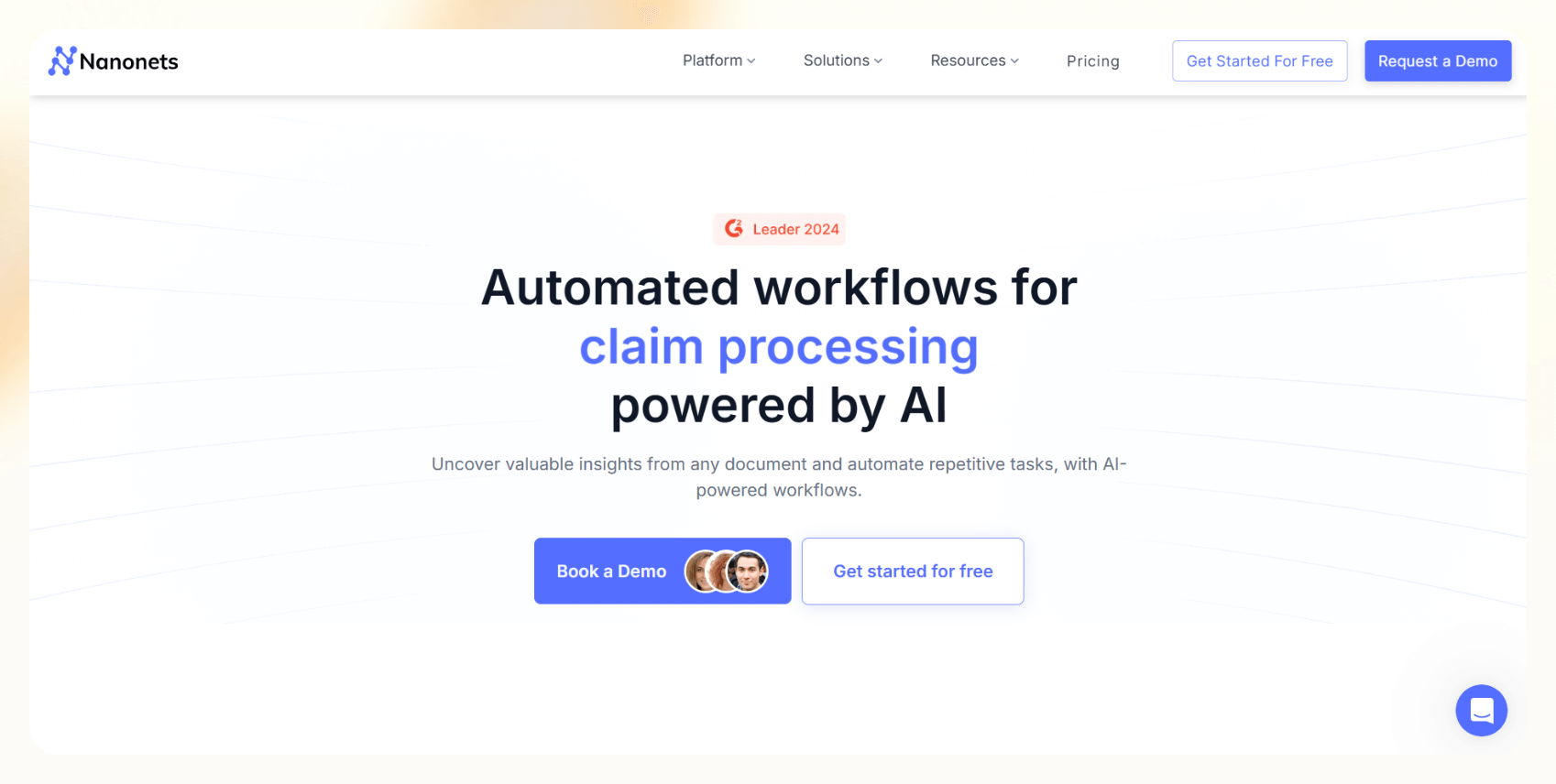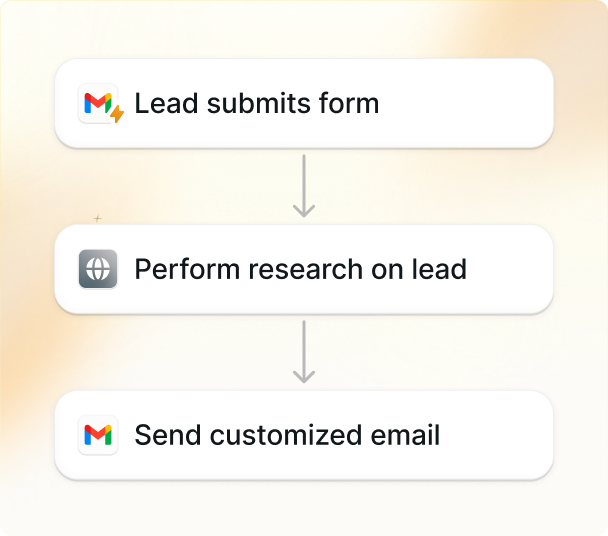Slackbots can save you time by automatically responding to your coworker’s questions, bringing up data from other software like a CRM system, and executing several different tasks.
Did you know that you don’t need to be a coding whiz to create your Slackbot?
Read on to learn more about:
- Why businesses use Slackbots and tasks they can execute
- How to create a Slackbot without code vs. with traditional coding
- A 7-step guide for building a Slackbot
- Why Lindy.ai is the best platform for making a Slackbot
- Some other tools for building Slackbots
- Frequently asked questions and other ways Lindy can help
What is a Slackbot?
A Slackbot is a digital assistant that lives inside your Slack workspace. It can respond to messages and transfer data from other apps, saving you from repetitive work. Slackbots can execute several tasks, including:
- An Answer Slackbot (FAQ Bot) that listens to specific questions and replies with pre-written answers — perfect for onboarding, IT support, or HR FAQs.
- Reminder Slackbots for sending scheduled or trigger-based reminders in a Slack channel — like nudging your team every Friday to submit timesheets.
- Support Escalation Slackbots for routing tickets or customer messages from your website to the correct team Slack channel based on topic, priority, or keywords — speeding up your support workflow.
How do Slackbots work?
Essentially, 2 types of Slackbot exist: Old school, conditionally-formatted Slackbots and modern, AI-powered Slackbots.
Founded in the ancient days of the mid-2010s, traditional Slackbots work with if-this-then-that logic. They respond to specific triggers, like a message containing a keyword or a scheduled time.
Modern Slackbots, on the other hand, use AI and natural language processing to interpret intent, hold conversations, and search knowledge bases. They’re powered by large language models (LLMs) like ChatGPT and Claude, allowing them to understand messy questions, summarize long threads, or suggest context-based actions.
The main difference between the two Slackbot types is that classic Slackbots can only follow if-then logic and respond to specific keywords. AI-powered Slackbots can understand messy commands, interpret intent, and pull data across multiple platforms, like your CRM, website, email, or other sources.
Ultimately, although traditional Slackbots still have their place, AI-powered Slackbots have become increasingly popular due to their flexibility and intelligence.
Why do businesses use Slackbots?
Slackbots free up loads of time by automating repetitive tasks, such as sending daily reminders, updating team members about new leads, logging feedback into spreadsheets, and more.
For example, sales teams can set up a Slackbot to alert them when a new HubSpot contact is added. At the same time, HR might use one to automatically answer common onboarding questions like “Where’s the vacation policy?”
Beyond time savings, Slackbots also streamline workflows by connecting with tools like Google Sheets, Notion, Salesforce, and Jira, automating actions across these platforms. Your marketing team, for instance, could use a Slackbot to turn newsletter signups into Airtable entries while putting the entries in your CRM.
Is it hard to code a Slackbot?
The short answer: Yes, building a Slackbot with a coding language like Python, Node.js, or Java is a difficult task. This is because you’ll need to deal with complex hosting and deployment, provisioning an AWS Lambda function, and setting up several APIs.
Developers face ongoing maintenance even after launch, like updating code when APIs change or Slack updates roll out. Because of the high probability of headaches, many Slack developers abandon developing their Slackbot with code and opt for a no-code Slackbot platform.
You can build a Slackbot with a no-code platform (a tool that doesn’t require learning programming). These Slackbot builders use a drag-and-drop interface, which is a lot like building a PowerPoint — you’ll add integrations and type in commands, so your Slackbot organizes your information as you wish.
How to create a Slackbot without coding
As we mentioned, nearly anyone can create their own customized Slackbot using a no-code platform. We’ll walk you through 7 easy and actionable steps, allowing you to have a finished product pretty quickly.
Step 1: Define your Slackbot’s purpose & triggers
Before you start creating your Slackbot, get a crystal clear understanding of what tasks it will execute. Is it going to answer common HR questions? Alert your team when a lead is added to the CRM? Send daily meeting reminders?
Jot down these ideas in a note or doc — even a rough sketch of its logical flow will help shape your Slackbot and avoid confusion later.
Next, think about how your Slackbot will know when to “wake up” — in automation-speak, actions that wake up Slackbots are called triggers. Triggers can be the following:
- A specific keyword a user asks you on Slack, like “PTO policy.”
- A scheduled time, such as every “Monday at 10AM…
- A condition-based trigger, like “whenever a new CRM profile is created, share with the sales team.”
Once you’ve decided what tasks your Slackbot will execute and the triggers that will start them, it’s time to select a no-code Slackbot builder.
Step 2: Choose a no-code Slackbot builder
Once you’ve defined your bot’s purpose, the next step is picking a Slackbot builder. Our top-tier platforms include Lindy, Zapier, Nanonets, and Brilo.ai — each offers a simple, user-friendly interface designed to help you make a Slackbot without writing a single line of code.
We prefer Lindy because it integrates with several third-party apps, such as Airtable, HubSpot, Google Calendar, and many more. The advanced no-code platform allows you to create various types of AI agents, including Slackbots, to automate workflows such as scheduling meetings and pulling data from CRMs.
Step 3: Connect your Slack app
Now that you’ve selected your no-code platform, it’s time to bring your Slackbot to life — you’ll set the triggers that will wake your Slackbot up and get it to work. Connect your no-code builder to your Slack workspace to install the bot into your Slack environment.
Most platforms like Lindy or Zapier will walk you through this with a few clicks, prompting you to log in and approve the connection. This lets your Slackbot listen, gather data from other apps, and post messages in selected channels.
After connecting, you’ll need to authorize permissions so your Slackbot can read messages, send replies, or access files. Click the boxes and you’re nearly halfway through.
Step 4: Customize responses & workflows
This is where you’ll add prompts that command your Slackbot how and when to execute tasks, follow-ups, and more. You can define your conversation logic using drag-and-drop workflow editors, making it easy to map out how your bot should respond based on user input.
Whatever task you assign — like escalating to a human, pulling info from a CRM, or summarizing meeting notes, this step is where your Slackbot onboards to your team.
Step 5: Integrate your Slackbot with other apps
Now that your Slackbot has all its commands, it’s time to integrate it with other apps — this is where all the fun stuff happens. These can be apps and software that your team already uses, such as Salesforce, HubSpot, Gmail, and others.
Integrating your external apps with your Slackbot allows you to transfer data between the platforms. This lets you cut out and automate manual and repetitive tasks. For instance, use this to notify your accounting team that a customer has paid for your services using a Slack integration.
Step 6: Test your Slackbot
With your prompts ready and your integrations plugged in, it’s time to run a few tests to tie up any loose ends. Platforms like Lindy include a helpful test function on the building interface. These let you simulate messages, trigger workflows, and preview responses.
Pay close attention to how your Slackbot handles different inputs: Does it understand typos, respond with accurate info, or send messages to the right party when needed? If not, you’ll need to tweak prompts, adjust conditions, or fine-tune your knowledge base.
For example, if your bot is supposed to send a Slack alert when a new calendar event is added, run a test event to see if the notification is sent properly. In the end, a few minutes of testing can save you hours of confusion later.
Step 7: Deploy & optimize your Slackbot
With testing complete, it’s time to launch your Slackbot and introduce it to your team. Start by adding it to relevant channels and then walk your team through how it works. Share examples like “Try asking @Bot ‘What’s our refund policy?’” so your team can engage from day one.
Once your Slackbot is live, you’ll need to continually monitor its performance. Most no-code platforms (like Lindy) let you track metrics like response accuracy, usage trends, and failed triggers.
If users ask questions your bot can’t answer, update your knowledge base or refine prompts accordingly. Then, give each update a test run to ensure it runs correctly.
Our top 3 no-code Slackbot builders
Now that you have a general idea about how simple it is to make a Slackbot without code let’s now discuss a few platforms that allow you to do so. Here’s a review of our 3 favorite Slackbot-building platforms:
Lindy: Our favorite Slackbot builder

Best for
Lindy excels at building all kinds of AI agents and can create many different Slackbots for your company. Plus, you’ll be able to get your building started very quickly by leveraging its premade templates and simple no-code building interface.
Key features
- A straightforward drag-and-drop, no-code visual editor is easy enough to learn right out of the box — no technical skills are required.
- Connect your Slackbot to internal documents, Google Drive, Notion pages, websites, and PDFs to get nearly any information.
- Integrate your Slackbot with your Lindy voice AI or your Lindy website chatbot, and notify your sales team when a lead expresses interest in purchasing your product or services.
- Lindy integrates with a growing number of third-party apps, and can connect to others via API. For instance, you can create a comment on ClickUp and notify your team about it with your Slackbot.
Why it’s better
Lindy lets you select the language model your Slackbot will use as its “brain” — pick from various ChatGPT, Claude, or Gemini models. You can choose one of the more powerful options, like GPT-o1, or something cost-effective, like Gemini.
You’ll also find that Lindy executes many more tasks than just building a Slackbot — you’ll be able to create AI phone agents, personal assistants, and even an email negotiator.
Zapier: Over 6,000 automations

Best for
Zapier is one of the original no-code automation tools. Boasting one of the largest suites of integrations, it’s ideal for individuals, marketers, operations teams, and even enterprise users looking to streamline day-to-day workflows.
Drawbacks
While Zapier is incredibly flexible, it’s not ideal for tasks that require complex natural language understanding. For instance, some Slackbot-builders, like Lindy, allow you to choose your LLM, so if your Slackbot needs to execute complex tasks, you can pick an LLM like ChatGPT o1.
Yet, Zapier has a set LLM, so it may have issues dealing with more complicated prompts that require high-level reasoning.
Why use it?
Zapier is great for rule-based Slackbots or automating cross-platform workflows without needing developer help or API knowledge. It’s fast, intuitive, and well-documented, which can be powerful if you connect Slack to your CRM, project management tools, or email platform.
Nanonets: Best for Slackbots that work with raw data

Best for
Nanonets is best for large companies and enterprise teams looking to automate data-heavy workflows inside Slack. It excels at handling raw, messy data from APIs, spreadsheets, CRMs, and more. Use Nanonets to build Slackbots that extract and validate purchase order data, match it against packing lists, or even analyze inventory and forecast demand trends — all directly from Slack.
Drawbacks
Nanonets may be overkill for small or mid-sized businesses that want a simple Slackbot. Additionally, the initial setup requires a clear understanding of your data pipelines, which may present a learning curve for non-technical users.
Why use it?
If you’re a large organization and want a Slackbot that can ingest raw data, clean it, analyze trends, and route it to the right destination or team, Nanonets is an excellent bet. For example, an operations team could create a Slackbot that automatically extracts line items from hundreds of vendor invoices, validates them against inventory, and notifies finance of discrepancies.
Picking the right Slackbot building platform
Lindy, Zapier, and Nanonets all have free versions. We recommend you give each one a shot. Before trying out a platform, ensure you have your list of functionalities. Then, try out each free platform, create one or two Slackbots, and test them out with a few coworkers.
You should look for a Slackbot that consistently fetches accurate data — test early and often after release to ensure reliability.
Frequently asked questions
Can I create a Slackbot for free?
Yes — our top 3 Slackbot builders each offer a free version. However, to unleash the full power of a Slackbot building platform with integrations and complex commands, you’ll need to go with a paid version. Free Slackbot builders are intended for taking the platform on a test drive.
Can I build a Slackbot for customer support?
No-code platforms like Lindy or Zapier make building a Slackbot for customer support easy. These bots can automatically respond to common questions by connecting with your website chatbot, pull answers from your internal knowledge base, escalate complex issues, and even log tickets in tools like Zendesk or HubSpot.
How do I update my Slackbot?
To update your Slackbot, open your no-code builder, locate your bot’s workflow, and make the necessary changes. You can tweak a prompt, add new triggers, edit your knowledge base, or update connected apps.
After saving, remember to test the updated flow to ensure everything works smoothly. Platforms like Lindy let you edit Slackbots in real-time, so your changes go live instantly. Regular updates help your Slackbot stay accurate, practical, and aligned with evolving team needs.
What’s the difference between a Slackbot and an AI-powered Slackbot?
A Slackbot is typically a rule-based automation that responds to specific triggers — like keywords, commands, or schedules — with pre-programmed actions or replies. It doesn’t “understand” context and can only perform what it’s explicitly told to do.
An AI-powered Slackbot, on the other hand, uses technologies like natural language processing (NLP) and large language models (e.g., GPT-4) to interpret intent, hold conversations, and respond dynamically. It can search knowledge bases, summarize threads, and adapt responses. This makes it much more flexible and allows it to provide clear and precise answers.
Create your next Slackbot with Lindy
Convinced that you need to build your own Slackbot? Lindy offers the perfect no-code platform to create one — you won’t need any programming skills or technical expertise. Here’s why you should go with Lindy:
- Create a Slackbot in minutes: Just use Lindy’s premade Support Slackbot template, and you’ll be able to retrieve messages sent by your colleagues. It also lets you automate your own responses to free up some time.
- Notify your team: When a Lindy voice agent or AI chatbot puts new lead information into your CRM or database, your Slackbot can notify your sales team, helping ensure quick responses to potential customers.
- Upload meeting notes: Forget manually attaching meeting minutes to lengthy email threads. Lindy can distribute meeting notes via Slack, either to channels or individuals, depending on how your workflow is set up.
- Onboarding made easy: Tracks when new users join your Slack workspace and logs their info into Google Sheets or Airtable.
Ready to make your own Slackbot in just a few minutes? Try Lindy for free today and use the Slackbot template to get started.
.png)












.png)
.png)




